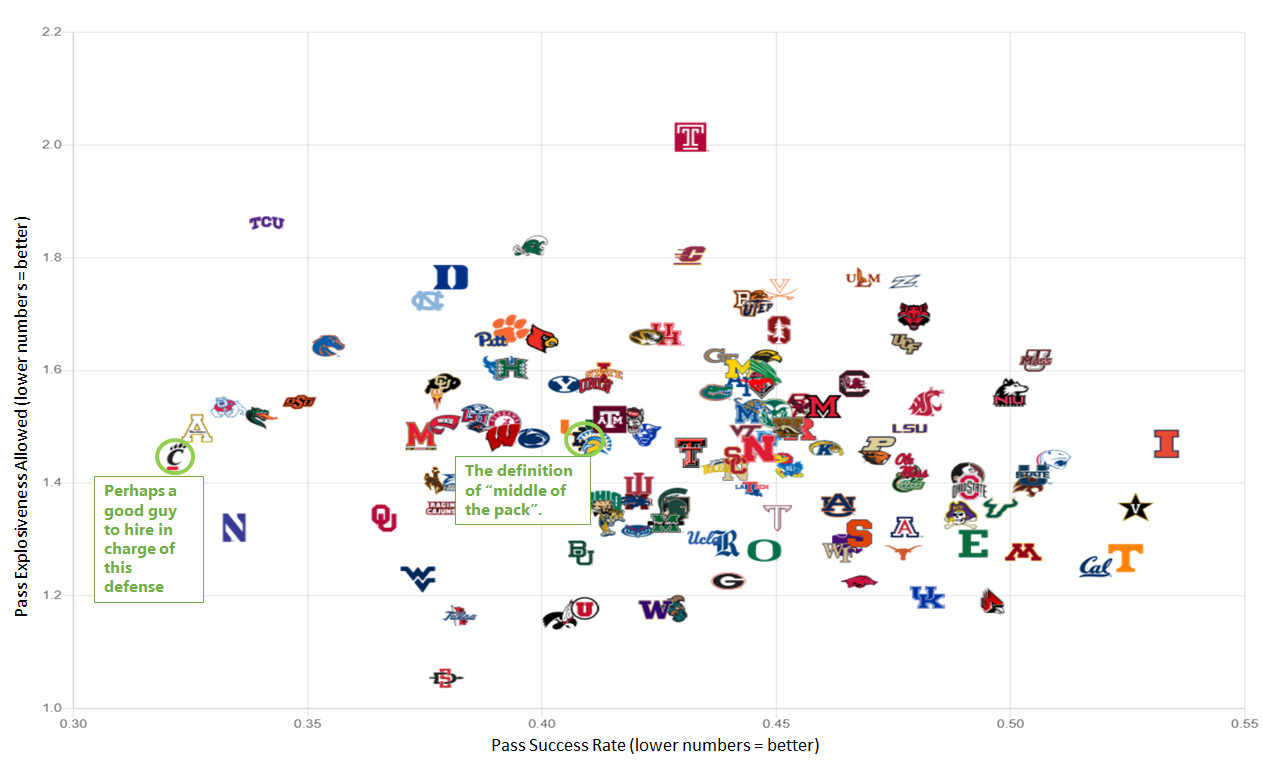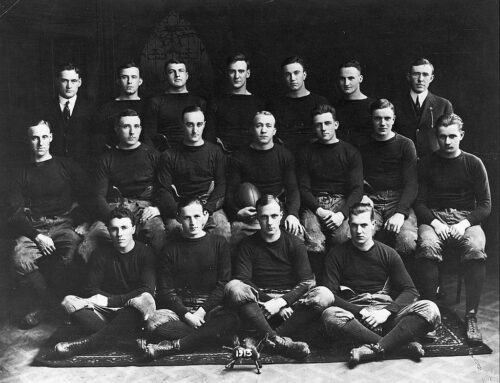The Irish pass defense in 2020 was solid against the soft underbelly of the ACC, spectacular for a half against Sam Howell in Chapel Hill, and was exploited by playoff-level attacks three times. Diving into the numbers shows a unit that declined relative to past seasons, even if excluding the Clemson and Alabama games. Passing downs in particular were a much bigger challenge for a group that excelled in those situations under Clark Lea and Mike Elko the year prior. With one returning star and many players looking for a breakout or redemption in the secondary, how can the Notre Dame passing defense get back on track?
Previous deep dives:
Passing Efficiency Allowed

As with the running defense, the 2020 Notre Dame passing defense unfairly suffers from Alabama and Clemson-induced inflation. Navy was notably absent on the schedule and there was only one G5 team in USF, so the average strength of opponent was higher than normal in last year’s glued-together schedule.
Still, last year’s numbers are disheartening for the pass defense, easily the worst performance in the Clark Lea era and far closer to 2017’s “happy to be competitive again” year than 2019. This could be a calculated trade-off – the Irish had a much higher havoc rate than usual in 2020. But it may have also been a reflection of personnel gaps that Lea had to duct tape over with cornerback and one safety spot perilously thin.

Clark Lea smartly engineered a defense around two spectacular pieces in Hamilton and Owusu-Koramoah. It allowed the Irish to stay in their base defense, using JOK as the de facto nickel corner on passing downs, and deploy them to eliminate the most dangerous opposing passing threats. Having that combination of talents was like playing chess with two queens, and critically covered up some holes at cornerback, where a grad transfer and true freshman ended the year as the two most reliable options. It wasn’t bulletproof – remember Shaun Crawford getting isolated against FSU’s Tamorrion Terry, or the first quarter of the UNC game? But it generally got the job done, with some help from a schedule that wasn’t filled with dynamic passing attacks – the lower tier of the schedule with Duke, FSU, Georgia Tech, Pitt, and Syracuse struggled mightily through the air.
Before digging into the numbers, you could imagine the decline was simply a result of playing Clemson twice and a historic Alabama offense. But the performances against mediocre ACC attacks were far from dominant, with the exception of totally inept attacks at Pittsburgh (with a backup QB) and Georgia Tech. Even removing the three games against Clemson and Alabama – where the numbers show the extent to which the Irish defense was shredded – the metrics are still significantly worse limiting pass efficiency and explosiveness than the 2018 and 2019 benchmarks.

To reach their goals the Irish will simply have to be better in 2021, especially with the four strongest opponents featuring blue-chip QBs, including three potential Round 1-2 picks.
Passing Explosiveness Allowed

The general formula for Clark Lea’s success was not overly complicated. Bend but don’t break is incredibly sensible, especially when you have a talent advantage over opposing offenses in almost every game. Force inferior talent to string a lot of plays together rather than getting unlucky and letting a deep ball go over your head. Inevitably they’ll make mistakes, or your talent will make plays, and then it’s time to capitalize when teams face passing downs. In previous seasons the last step in this approach was incredibly successful – the Irish ranked near the top of FBS in opponent success rate on passing downs and gave up relatively few big plays.
One key issue with the 2020 pass defense was that suddenly the Irish were dramatically worse in these passing down situations (2nd and 8 yards or more to gain, 3rd and 5 or more). Compared to 2019 – a solid pass defense, but not one songs will be written about – the 2020 defense gave up more than double the rate of explosive (16+) yard gains, skyrocketing from 6.4% of opponent attempts to 15.2%. The pass defense also gave up more than 2.5 more yards per attempt on these plays and allowed a success rate over 10% higher. Not great!

The Irish actually allowed more yards per attempt last season on passing downs than standard downs, where they were less likely to know what was coming. Marcus Freeman will have his work cut out for him, but as you can see above, his work last year at Cincinnati was pretty legendary as the Bearcats had a good case for one of the best passing defenses in the nation. The one watch-out is that his defenses were frequently penalized, with Cincinnati finishing 7th in penalties per game in 2020.
The final element to consider is the strength of the Irish pass rush – Notre Dame returns exactly 50% of its sacks from last fall. The Irish were middle of the pack nationally in sack rate, finishing 42nd overall but faring better on standard downs (32nd) than passing downs (60th). Those numbers may understate the defensive line’s impact generating pressure, as the pass rushers graded out more favorably in PFF’s metrics.
Still, it leaves another uncertain variable as two of the three leading pass rushers depart with Ade Ogundeji and Daelin Hayes now playing on Sundays. Isaiah Foskey was second on the team with 4.5 sacks and is now being counted on to step into an even larger role. Jordan Botelho provides another enticing option, especially if paired with Foskey on third down packages. The strong pressure from the interior should remain intact with eight or nine strong options available between the defensive tackles. When players like Howard Cross and Rylie Mills are fighting for meaningful snaps after showing promise in ACC play as underclassmen, that’s a great sign.
A final variable to watch is the pass-rushing involvement of the linebackers and secondary. For all of their disruption last season, Owusu-Koramoah, White, Liufau, and Simon combined for 3.5 sacks. Shaun Crawford notched two sacks last season but Kyle Hamilton’s next sack will be his first in a Notre Dame uniform. Freeman may be more aggressive bringing linebackers and safeties both on early and passing downs, especially if the front four aren’t consistently generating pressure on their own.
2021 Outlook
It’s important to note that last year looks like a struggle up against the high bar the Irish pass defense had set. For the season Notre Dame finished top-40 in opponent passer rating, even with the Mac Jones, Trevor Lawrence, Sam Howell, and DJ Uiagalelei gauntlet. But the unit remains a cause for some concern because after regression last season there’s still a lack of continuity and proven options beyond Hamilton.
Griffith and DJ Brown provide limited experience at safety next to Hamilton, but both have a lot to prove. Clarence Lewis should build on a solid freshman campaign, but is he truly a number one corner? The rest of the cornerback position room is filled with guys with high ceilings but low floors. Tariq Bracy is the most experienced option but struggled mightily in his last appearances in 2020 before being demoted to a backup role. Cam Hart has earned rave practice reviews and provides size plus physicality, but he hasn’t taken meaningful game reps. And then there’s a collection of younger players like Ramon Henderson, Philip Riley, and KJ Wallace that we’ve seen very little of, even counting beat writers viewing practices.
The pass defense has arguably the widest range of potential outcomes of any component of a team with plenty of unknowns. As with wide receiver, it feels like the Irish have to bet on a few players from a sizeable group tapping into their potential and breaking out under Mike Mickens and Freeman’s tutelage. Lewis should improve and at a minimum proved a solid floor as a starter, and Bracy has shown tantalizing flashes in big games before. Hart and Henderson ooze potential. Houston Griffith has the pedigree and fresh start in a new defense that are easy building blocks for a comeback story. Last year was hard and weird, especially for younger players, and it’s worth noting that secondary was one of the harder hit units by the early season COVID outbreak.
Mickens and Freeman have done magical things at corner with less highly touted prospects in Cincinnati. The secondary will be asked to do different things, and players whose stock may have dropped or plateaued under the old defense may be reinvigorated. But if a few things break the wrong way, like Irish fans saw with the receiver room last year, it’s one of the biggerr areas of concern on the roster.




It’s still hard to believe that we held UNC to the 4th-worse passing success rate on our schedule last year and we pulled that off without Kyle Hamilton for two and a half quarters. That was a truly Herculean performance by our defense on that day.
It was and you have to give the DL (and Clark Lea) a ton of credit, they harassed the crap out of Howell and took away where he wanted to go with no time.
I do think that game warped the sense of how good the pass defense was though – it was an exceptional performance but they really didn’t dominate like those 2.5 quarters against worse competition. The rematch will be really interesting with our retooled pass rush and UNC’s whole line returning. Phil Longo is a really really good OC that I think has flown under the radar as most credit has gone to Howell and Mack.
A little trip to Longo beach coming up